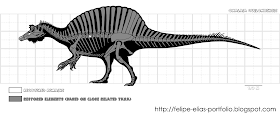Post by dinosauria101 on Aug 1, 2019 17:59:21 GMT 5
Oxalaia quilombensis
Oxalaia (in reference to the African deity Oxalá) is a genus of spinosaurid theropod dinosaur that lived in what is now the Northeast Region of Brazil during the Cenomanian stage of the Late Cretaceous Period, sometime between 100.5 and 93.9 million years ago. Its only known fossils were found in 1999 on Cajual Island in the rocks of the Alcântara Formation, which is known for its abundance of fragmentary, isolated fossil specimens. The holotype praemaxillae are together approximately 201 mm (7.9 in) long, with a preserved width of 115 mm (4.5 in) (maximal estimated original width is 126 mm (5.0 in)), and a height of 103 mm (4.1 in). Based on skeletal material from related spinosaurids, the skull of Oxalaia would have been an estimated 1.35 m (4 ft 5 in) long; this is smaller than Spinosaurus's skull, which was approximated at 1.75 m (5 ft 9 in) long by Italian palaeontologist Cristiano Dal Sasso and colleagues in 2005.[16] Kellner and his team compared the Dal Sasso specimen (MSNM V4047) to Oxalaia's original snout in 2011; from this they estimated Oxalaia at 12 to 14 metres (39 to 46 ft) in length and 5 to 7 tonnes (5.5 to 7.7 short tons) in weight, making it the largest known theropod from Brazil.

Rajasaurus narmadensis
Rajasaurus was an abelisaurid, a member of a group of theropod predators known to have lived only on landmasses that were part of the supercontinent Gondwana, such as Africa, India, Madagascar, and South America. Rajasaurus closely resembles Majungasaurus, a contemporary abelisaur from Madagascar, an island that had separated from the Indian landmass about 20 million years earlier. It was found to be an abelisaurid through a phylogenetic analysis of anatomical characteristics, and was described as a carnotaurine abelisaurid (the subfamily including Carnotaurus) because of the configuration of its nasal bones and its possession of a growth ("excrescence") on its frontal bone. Rajasaurus is distinguished from other genera by its single nasal-frontal horn, the elongated proportions of its supratemporal fenestrae (holes in the upper rear of the skull), and the form of the ilia (principle bones of the hip) which feature a transverse ridge separating the brevis shelf from the hip joint. Rajasaurus was identified from a partial skeleton including a well–preserved skull (with a complete braincase and 70% of the rest of the skull bones recovered), hip bones and parts of the hind legs, backbone and tail. This specimen, GSI 21141/1–33, serves as the type specimen of the genus and species. Rajasaurus measured about 7.6–9 m (24.9–29.5 ft) long, 2.4 m (7.9 ft) in height, and weighed about 3 to 4 tons. The skull was short, measuring 60 cm (23.6 in) in length, and bore a distinctive low rounded horn. This horn is made up of outgrowths from the nasal and frontal bones.

Credit to Wikipedia
Oxalaia (in reference to the African deity Oxalá) is a genus of spinosaurid theropod dinosaur that lived in what is now the Northeast Region of Brazil during the Cenomanian stage of the Late Cretaceous Period, sometime between 100.5 and 93.9 million years ago. Its only known fossils were found in 1999 on Cajual Island in the rocks of the Alcântara Formation, which is known for its abundance of fragmentary, isolated fossil specimens. The holotype praemaxillae are together approximately 201 mm (7.9 in) long, with a preserved width of 115 mm (4.5 in) (maximal estimated original width is 126 mm (5.0 in)), and a height of 103 mm (4.1 in). Based on skeletal material from related spinosaurids, the skull of Oxalaia would have been an estimated 1.35 m (4 ft 5 in) long; this is smaller than Spinosaurus's skull, which was approximated at 1.75 m (5 ft 9 in) long by Italian palaeontologist Cristiano Dal Sasso and colleagues in 2005.[16] Kellner and his team compared the Dal Sasso specimen (MSNM V4047) to Oxalaia's original snout in 2011; from this they estimated Oxalaia at 12 to 14 metres (39 to 46 ft) in length and 5 to 7 tonnes (5.5 to 7.7 short tons) in weight, making it the largest known theropod from Brazil.

Rajasaurus narmadensis
Rajasaurus was an abelisaurid, a member of a group of theropod predators known to have lived only on landmasses that were part of the supercontinent Gondwana, such as Africa, India, Madagascar, and South America. Rajasaurus closely resembles Majungasaurus, a contemporary abelisaur from Madagascar, an island that had separated from the Indian landmass about 20 million years earlier. It was found to be an abelisaurid through a phylogenetic analysis of anatomical characteristics, and was described as a carnotaurine abelisaurid (the subfamily including Carnotaurus) because of the configuration of its nasal bones and its possession of a growth ("excrescence") on its frontal bone. Rajasaurus is distinguished from other genera by its single nasal-frontal horn, the elongated proportions of its supratemporal fenestrae (holes in the upper rear of the skull), and the form of the ilia (principle bones of the hip) which feature a transverse ridge separating the brevis shelf from the hip joint. Rajasaurus was identified from a partial skeleton including a well–preserved skull (with a complete braincase and 70% of the rest of the skull bones recovered), hip bones and parts of the hind legs, backbone and tail. This specimen, GSI 21141/1–33, serves as the type specimen of the genus and species. Rajasaurus measured about 7.6–9 m (24.9–29.5 ft) long, 2.4 m (7.9 ft) in height, and weighed about 3 to 4 tons. The skull was short, measuring 60 cm (23.6 in) in length, and bore a distinctive low rounded horn. This horn is made up of outgrowths from the nasal and frontal bones.

Credit to Wikipedia


